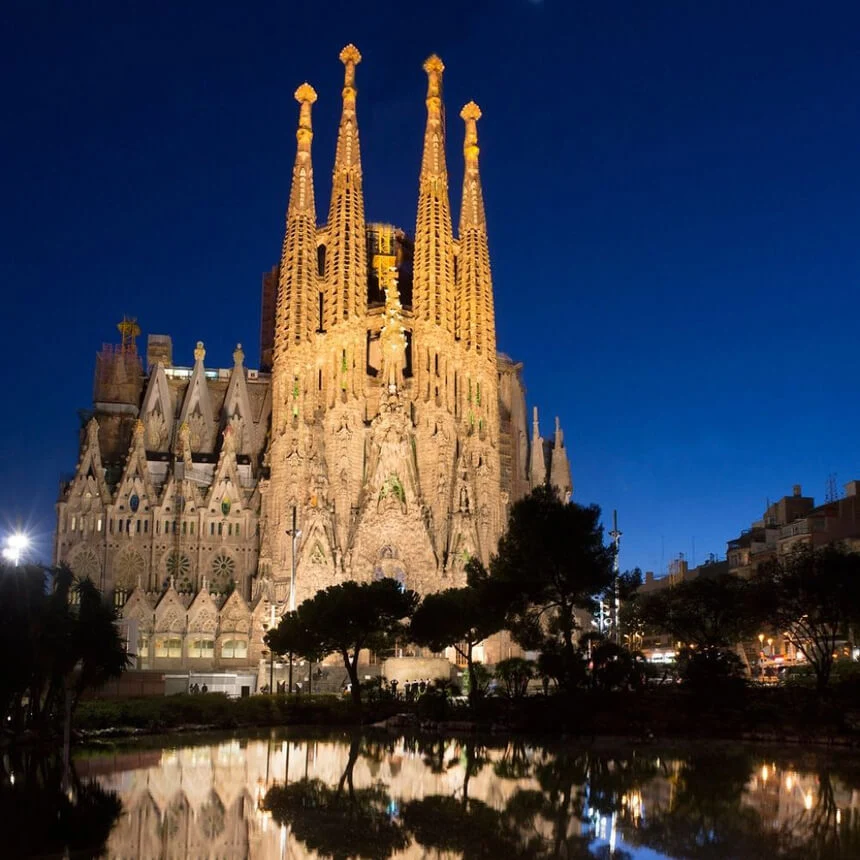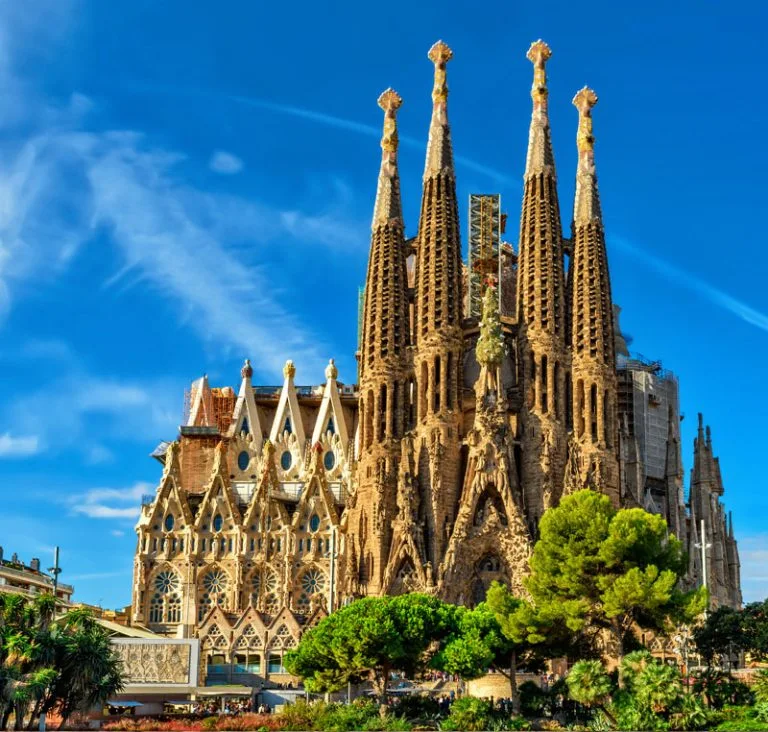Antoni Gaudi Architecture: A Masterpiece of Creativity and Ingenuity
Exploring and Defining Architecture of Gaudi
If you’ve ever been to Barcelona, chances are you’ve seen the unique and extravagant buildings that dot the city’s landscape. These stunning structures are the result of the genius architect, Antoni Gaudí. When one thinks of iconic architecture, the name Antoni Gaudí immediately springs to mind.
His unique and mesmerizing architectural style, known as "Gaudí architecture," has left an indelible mark on the world of design and continues to captivate generations. It is mainly known for its distinctive style and unconventional designs. From the iconic Sagrada Família — see the image below — to the whimsical Park Güell, his work continues to awe and inspire.
In this blog post, we’ll dive into the emergence, history, and characteristics of Gaudí's style, discovering what sets it apart from other architectural styles. |
| Image: The famous Sagrada Familia; Undoubtedly Gaudí's most famous work, in Barcelona, Spain. Image-source: live.staticflickr.com) |
Additionally, we will explore its fascinating history and evolution, and try to understand why it continues to be a source of inspiration for architects and enthusiasts alike.
So, if you’re a fan of art and history, or just appreciate some truly jaw-dropping buildings, keep reading!
A Quick Review of His Bio: Who is Antoni Gaudi?
— First, let's introduce who's the founder of Gaudi architecture?Antoni Gaudí, a renowned Spanish architect from Catalonia, is considered the mastermind and primary proponent of the architectural style commonly referred to as "Gaudí architecture."
 |
| Antoni Gaudi, Photo: Wikipedia |
Gaudí's innovative and unique approach to design, characterized by its organic forms (refer to the architecture characteristics below), innovative structural techniques, and integration of art and architecture, has left an indelible mark on the world of architecture and design.
While Gaudí did not formally fund a school or movement, his distinct style and visionary creations have come to define what is now commonly referred to as "Gaudí architecture."
Emergence and Historical Context
Understanding the historical context in which Gaudí's architecture emerged helps us appreciate the factors that shaped his innovative and avant-garde style.
- Art Nouveau Movement: Gaudí's architecture is closely linked to the Art Nouveau movement, which emerged in the late 19th century as a reaction against industrialization, emphasizing artistic expression and organic forms.
- Catalan Modernism: Gaudí's work is an embodiment of Catalan Modernism, a regional architectural style that sought to showcase Catalonia's distinct cultural identity through art and design.
- Religious and Symbolic Influences: Gaudí's deeply religious upbringing and spiritual beliefs had a significant impact on his architectural choices, as seen in the symbolism and religious motifs embedded in his works.
Main Characteristics of "Gaudí Architecture"
Gaudí architecture is characterized by several distinct features that set it apart from other architectural styles. These characteristics not only make it visually stunning but also contribute to its functionality and sustainability.
- Organic Forms: Gaudí's structures often imitate the shapes and forms found in nature, such as curvilinear lines, spirals, and intricate mosaics resembling natural textures.
- Innovative Structural Techniques: Gaudí pioneered the use of innovative structural techniques, such as the catenary arch and the hyperbolic paraboloid, which allowed for greater load distribution and unique spatial arrangements.
- Color and Material Diversity: Vibrant colors and a wide range of materials, including ceramics, stained glass, and wrought iron, are hallmarks of Gaudí's designs, adding a playful and dynamic element to his creations.
- Integration of Art and Architecture: Gaudí's architecture seamlessly integrates various art forms, blurring the lines between architecture, sculpture, and painting, resulting in holistic and harmonious structures.
- Sustainability and Functionality: Long before the modern sustainability movement, Gaudí incorporated eco-friendly elements into his designs, utilizing natural ventilation, solar orientation, and recycled materials.
Fascinating Facts about "Gaudí Architecture"
Gaudí's architectural wonders are not only visually striking but also carry intriguing stories and facts that make them even more captivating.
- Sagrada Família's Eternal Construction: The Sagrada Família, Gaudí's magnum opus, remains under construction since 1882 and is projected for completion in the 21st century, highlighting the dedication and patience required for such grandeur.
Undoubtedly Gaudí's most famous work, the Sagrada Família is a monumental basilica that has been under construction for over a century. Its breathtaking facade, intricate spires, and innovative architectural techniques reflect Gaudí's visionary approach to design.
The church has been in construction since 1882 and is expected to be completed in 2026. A total of 4.5 million tourists visit it every year, making it one of the most visited tourist attractions in Spain.
- Casa Batlló's Mythical Inspirations: Casa Batlló's undulating facade is said to be inspired by the legend of Saint George slaying the dragon, with the balconies resembling the dragon's scales.
 |
| Casa Batlló's elevation by Gaudi, Photo: Pinterest |
Casa Batlló is a residential building that showcases Gaudí's ability to manipulate materials and forms. Its undulating facade, intricate ironwork, and expressive details create an otherworldly appearance.
- Park Güell's Playful Essence: Park Güell's vibrant mosaics, serpentine benches, and whimsical structures showcase Gaudí's playful approach to architecture, inviting visitors to explore and engage.
 |
| Park Güell's, Photo: www.bcneventsandcrawls.com |
This public park is a whimsical wonderland of colorful mosaics, serpentine benches, and organic architecture. It was originally conceived as a housing development project but later transformed into a public park, showcasing Gaudí's playful and imaginative style.
Antoni Gaudí's creative genius is perhaps nowhere more evident than in the whimsical and enchanting landscape of Park Güell. This iconic public park, located on Carmel Hill in Barcelona, Spain, is a testament to Gaudí's unique architectural vision, blending natural forms, vibrant mosaics, and innovative design to create a space that feels like a magical dreamscape.
Recognizing the historical and artistic value of Park Güell, it was designated a UNESCO World Heritage Site in 1984. Today, it stands as a beloved destination for tourists and architecture enthusiasts from around the world. The park's influence is far-reaching, inspiring designers to explore the boundaries of creativity and innovation in their own projects.
- Casa Milà's Organic Aesthetics: Another residential building designed by Gaudí, Casa Milà stands out for its unique stone facade that evokes the look of natural rock formations. Its rooftop with whimsical chimneys and ventilation towers is a prime example of Gaudí's creative approach.
 |
| Casa Milà (La Pedrera), Photo: www.10cose.it |
One of Casa Milà's most striking features is its undulating stone facade, which appears to be sculpted by the forces of nature. Gaudí's design eliminates traditional load-bearing walls, allowing for a more fluid and innovative aesthetic.
Antoni Gaudi's Most Famous Works
Antoni Gaudí's architectural creations are predominantly concentrated in Barcelona, Spain, where he left an indelible mark on the cityscape. However, his influence has extended beyond Spain's borders, inspiring architects and designers around the world. Here are some of his remarkable architectural projects, that showcase the essence of Gaudí's style:
- Sagrada Família (Basilica and Expiatory Church of the Holy Family),
- Park Güell,
- Casa Batlló,
- Casa Milà (La Pedrera), Barcelona, Spain; Those are already discussed in our post above, all located in Barcelona, Spain. However, here is another list of fascinating projects that haven't been explored yet, including:
- Palau Güell, Barcelona, Spain
A mansion designed for the industrial tycoon Eusebi Güell, Palau Güell features Gaudí's signature use of vibrant colors, intricate details, and innovative spatial arrangements.
- Casa Vicens, Barcelona, Spain:
One of Gaudí's early works, Casa Vicens is a private residence that exhibits an eclectic mix of architectural styles, including Moorish, Gothic, and Art Nouveau influences.
- It is good to note, that while both architectural styles exhibit some common features related to artistic expression, innovation, and attention to detail, their underlying motivations, historical contexts, and design philosophies are distinct.
- Gaudí's architecture emerged during the late 19th and early 20th centuries as part of the Art Nouveau movement, whereas Gothic architecture flourished in the medieval era. The shared characteristics are more a result of the shared human impulse to create extraordinary spaces that evoke emotion, spirituality, and awe, rather than direct stylistic influence between the two.
- Crypt of the Colònia Güell, Santa Coloma de Cervelló, Spain:
Gaudí designed this crypt as part of a planned industrial village. Although the village was never fully realized, the crypt showcases his experimental use of structures and materials.
- Episcopal Palace of Astorga, Astorga, Spain:
While not as widely recognized as some of his other works, this palace features Gaudí's distinctive architectural elements, including curved lines, vibrant ceramic details, and expressive forms.
- Casa Calvet, Barcelona, Spain:
A more understated example of Gaudí's work, Casa Calvet features a symmetrical facade with intricate ironwork and sculptural details, showcasing his ability to adapt his style to different contexts.
Gaudí-inspired Architecture Around the World
Gaudí's influence has transcended Spain, inspiring architects and designers globally. Various buildings and structures in different parts of the world pay homage to his style, incorporating organic forms, mosaic work, and innovative techniques.
While these projects directly showcase Gaudí's architectural style, it's worth noting that his influence extends beyond these specific examples. Architects, artists, and designers continue to draw inspiration from his groundbreaking work, incorporating elements of Gaudí's aesthetic into modern creations that pay tribute to his legacy.
Legacy and Global Impact
The architecture of Gaudí transcends time and borders, leaving a lasting impact on the architectural world and inspiring countless designers.
- Architectural Inspiration: Architects around the world draw inspiration from Gaudí's innovative techniques, his ability to blur art and architecture, and his sustainable design principles.
- Tourist Attractions: Gaudí's creations, particularly in Barcelona, have become major tourist attractions, contributing significantly to the city's cultural and economic landscape.
- UNESCO World Heritage: Several of Gaudí's works, including the Sagrada Família, Park Güell, and Casa Batlló, have been designated as UNESCO World Heritage Sites, ensuring their preservation for future generations.
Final Words
Antoni Gaudí is more than just a style; it's a testament to the boundless imagination and creative genius of Antoni Gaudí. With its organic forms, innovative techniques, and integration of art and architecture, Gaudí's works continue to capture the hearts of those who encounter them.
As we explore the characteristics, facts, history, and global impact of Gaudí architecture, it becomes evident that his legacy is one of awe-inspiring beauty and everlasting inspiration. So, whether you're an architecture enthusiast or simply someone who appreciates the beauty of design, Gaudí's creations are sure to leave an indelible mark on your mind and soul.
.png)







